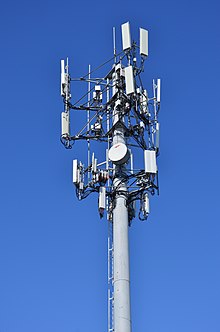 Multiple patch (rectangular) antennas found atop a Cellular Tower | |
| Working principle | Electromagnetic radiation |
|---|---|
| Invented | Heinrich Hertz (1888) |
| Electronic symbol | |
  | |
In radio engineering, an antenna (American English) or aerial (British English) is an electronic device that converts an alternating electric current into radio waves (transmitting), or radio waves into an electric current (receiving).[1][2] It is the interface between radio waves propagating through space and electric currents moving in metal conductors, used with a transmitter or receiver.[1] In transmission, a radio transmitter supplies an electric current to the antenna's terminals, and the antenna radiates the energy from the current as electromagnetic waves (radio waves). In reception, an antenna intercepts some of the power of a radio wave in order to produce an electric current at its terminals, that is applied to a receiver to be amplified. Antennas are essential components of all radio equipment.[3]
An antenna is an array of conductors (elements), electrically connected to the receiver or transmitter. Antennas can be designed to transmit and receive radio waves in all horizontal directions equally (omnidirectional antennas), or preferentially in a particular direction (directional, or high-gain, or "beam" antennas). An antenna may include components not connected to the transmitter, parabolic reflectors, horns, or parasitic elements, which serve to direct the radio waves into a beam or other desired radiation pattern. Strong directivity and good efficiency when transmitting are hard to achieve with antennas with dimensions that are much smaller than a half wavelength.
The first antennas were built in 1888 by German physicist Heinrich Hertz in his pioneering experiments to prove the existence of electromagnetic waves predicted by the 1867 electromagnetic theory of James Clerk Maxwell. Hertz placed dipole antennas at the focal point of parabolic reflectors for both transmitting and receiving.[4] Starting in 1895, Guglielmo Marconi began development of antennas practical for long-distance, wireless telegraphy, for which he received the 1909 Nobel Prize in physics.[5]
- ^ a b Graf, Rudolf F., ed. (1999). "Antenna". Modern Dictionary of Electronics. Newnes. p. 29. ISBN 978-0750698665.
- ^ Horak, Ray (2008). Webster's New World Telecom Dictionary. John Wiley and Sons. p. 34. ISBN 9780471774570.
- ^ AMARAL, Cristiano (2021). Guia Moderno do Radioescuta. Brasília: Amazon. ISBN 978-65-00-20800-9.
- ^ Hertz, H. (1889). "[no title cited]". Annalen der Physik und Chemie. 36.
- ^ Cite error: The named reference
marconi_nobelwas invoked but never defined (see the help page).

